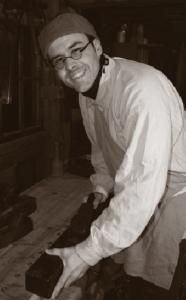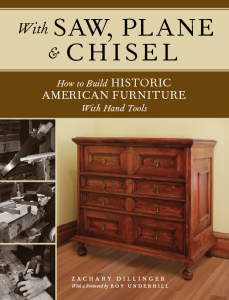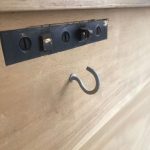Don’t miss Zach Dillinger at Woodworking in America at the Northern Kentucky Convention Center, September 16-18.

We may receive a commission when you use our affiliate links. However, this does not impact our recommendations.
 Zach Dillinger specializes in building 18th century American furniture with hand tools and period appropriate techniques. He is a member of the Great Lakes Chapter of the Society of American Period Furniture Makers, and the Mid-West Tool Collectors Association. He’s written for numerous publications and websites including his own, The Eaton County Woodworker. His work has been adjudged to be Museum Quality by Early American Life and has been juried into that publication’s prestigious “Directory of Traditional American Crafts” for the past three years. Zach will be teaching at Woodworking in America at the Northern Kentucky Convention Center, September 16-18.
Zach Dillinger specializes in building 18th century American furniture with hand tools and period appropriate techniques. He is a member of the Great Lakes Chapter of the Society of American Period Furniture Makers, and the Mid-West Tool Collectors Association. He’s written for numerous publications and websites including his own, The Eaton County Woodworker. His work has been adjudged to be Museum Quality by Early American Life and has been juried into that publication’s prestigious “Directory of Traditional American Crafts” for the past three years. Zach will be teaching at Woodworking in America at the Northern Kentucky Convention Center, September 16-18.
You work solely with hand tools in order to accurately reproduce period furniture. That said, how has your approach evolved over time—do you find yourself going deeper down the rabbit hole?
Even though my tooling has stayed roughly the same, my approach has definitely changed over time. When I first started building accurate reproductions it was important to me to replicate the pieces as they are now, grungy, dirty, damaged from 200 or more years of existence. While I still love working this way, I have moderated that approach a little, focusing in many cases on making a piece that looks as it would have when it was new. This means that while you still see tool marks, overcuts in joinery and surface tearout in my work, you also see shinier finishes, no simulated oxidation, or other faux signs of age. The pieces are, in my own opinion, stronger for it, and it enables me to display two pieces side by side, one aged and one new, and show how subtle changes make a huge difference to the overall presentation.
Do you have a particular piece that you’re most proud of?
I am most proud of my exact reproduction of a c.1700 painted chest of drawers. The original is in the Metropolitan Museum of Art and I worked with their conservators to get the exact paint recipes, excellent photographs of the interior surfaces and decoration. I feel confident in saying this was by far the most technically difficult piece I have completed, not just the woodwork (there is over 30 feet of mitered moldings used as surface decoration) but mainly the painted decoration. You will see a stained version of this dresser in my forthcoming book.
Speaking of your new book, would mind talking a little about the work that went into that?
The book, “With Saw, Plane and Chisel”, was an immense amount of work. I’m very fortunate to have had such a great team of folks to share the workload. We’ve had the best of the best in all areas of production, I was able to get several top quality contributors to help me in areas where I can’t speak with authority (two examples: upholstery was handled by the incredibly talented Michael Mascelli, and a primer on furniture styles by noted historian Robert F. Trent). We were also able to get Roy Underhill to write the forward. It is a dream come true to have been able to work with so many great folks including my personal hero Roy (thanks Roy!).
The book has six projects that represent all the major styles of American furniture from the late 17th century into the early 19th century. We also have more general chapters on everything from how to prepare stock by hand (hint, its easier than a lot of people make it!) to cutting the finest of joints to hold the pieces together. I couldn’t be prouder of this book, and I hope many WIA attendees will consider picking it up when it is released later this year.
What are you currently working on?
My main focus since finishing the book has been in being a good dad to my four-month-old daughter Abigail. I haven’t been in the shop much since finishing the book but I’m always thinking about what to build next. I am currently torn between a reproduction of a c.1650 Dutch valuables chest on stand from the Rijksmuseum, or a piece of Classical furniture along the lines of Lannuier, perhaps something from the Cincinnati Classical school. We’ll see how much I spend at WIA before deciding (good mahogany for a classical piece is expensive!).
What are you looking forward to most at WIA?
I’m looking forward to learning from my fellow presenters as much as possible and also the attendees. It is my firm belief that you can learn something from everyone you come into contact with, and WIA is a great way to meet a large group of folks with like interests. There are a number of folks whom I only “know” online or through their writings and I’m ecstatic to be able to meet with them. Another thing I’m looking forward to is the Marketplace … the last thing I need to do is buy more tools but I have a suspicion that memories and photographs won’t be the only things I come home with!
Here are some supplies and tools we find essential in our everyday work around the shop. We may receive a commission from sales referred by our links; however, we have carefully selected these products for their usefulness and quality.










